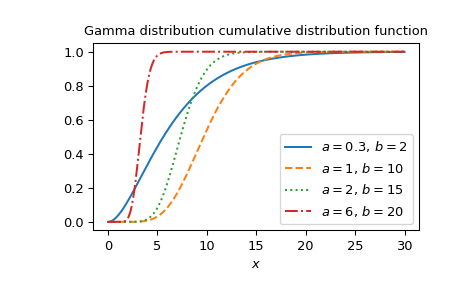scipy.special.gdtr#
- scipy.special.gdtr(a, b, x, out=None) = <ufunc 'gdtr'>#
Gamma distribution cumulative distribution function.
Returns the integral from zero to x of the gamma probability density function,
\[F = \int_0^x \frac{a^b}{\Gamma(b)} t^{b-1} e^{-at}\,dt,\]where \(\Gamma\) is the gamma function.
- Parameters:
- aarray_like
The rate parameter of the gamma distribution, sometimes denoted \(\beta\) (float). It is also the reciprocal of the scale parameter \(\theta\).
- barray_like
The shape parameter of the gamma distribution, sometimes denoted \(\alpha\) (float).
- xarray_like
The quantile (upper limit of integration; float).
- outndarray, optional
Optional output array for the function values
- Returns:
- Fscalar or ndarray
The CDF of the gamma distribution with parameters a and b evaluated at x.
See also
gdtrc1 - CDF of the gamma distribution.
scipy.stats.gammaGamma distribution
Notes
The evaluation is carried out using the relation to the incomplete gamma integral (regularized gamma function).
Wrapper for the Cephes [1] routine
gdtr. Callinggdtrdirectly can improve performance compared to thecdfmethod ofscipy.stats.gamma(see last example below).References
[1]Cephes Mathematical Functions Library, http://www.netlib.org/cephes/
Examples
Compute the function for
a=1,b=2atx=5.>>> import numpy as np >>> from scipy.special import gdtr >>> import matplotlib.pyplot as plt >>> gdtr(1., 2., 5.) 0.9595723180054873
Compute the function for
a=1andb=2at several points by providing a NumPy array for x.>>> xvalues = np.array([1., 2., 3., 4]) >>> gdtr(1., 1., xvalues) array([0.63212056, 0.86466472, 0.95021293, 0.98168436])
gdtrcan evaluate different parameter sets by providing arrays with broadcasting compatible shapes for a, b and x. Here we compute the function for three different a at four positions x andb=3, resulting in a 3x4 array.>>> a = np.array([[0.5], [1.5], [2.5]]) >>> x = np.array([1., 2., 3., 4]) >>> a.shape, x.shape ((3, 1), (4,))
>>> gdtr(a, 3., x) array([[0.01438768, 0.0803014 , 0.19115317, 0.32332358], [0.19115317, 0.57680992, 0.82642193, 0.9380312 ], [0.45618688, 0.87534798, 0.97974328, 0.9972306 ]])
Plot the function for four different parameter sets.
>>> a_parameters = [0.3, 1, 2, 6] >>> b_parameters = [2, 10, 15, 20] >>> linestyles = ['solid', 'dashed', 'dotted', 'dashdot'] >>> parameters_list = list(zip(a_parameters, b_parameters, linestyles)) >>> x = np.linspace(0, 30, 1000) >>> fig, ax = plt.subplots() >>> for parameter_set in parameters_list: ... a, b, style = parameter_set ... gdtr_vals = gdtr(a, b, x) ... ax.plot(x, gdtr_vals, label=fr"$a= {a},\, b={b}$", ls=style) >>> ax.legend() >>> ax.set_xlabel("$x$") >>> ax.set_title("Gamma distribution cumulative distribution function") >>> plt.show()

The gamma distribution is also available as
scipy.stats.gamma. Usinggdtrdirectly can be much faster than calling thecdfmethod ofscipy.stats.gamma, especially for small arrays or individual values. To get the same results one must use the following parametrization:stats.gamma(b, scale=1/a).cdf(x)=gdtr(a, b, x).>>> from scipy.stats import gamma >>> a = 2. >>> b = 3 >>> x = 1. >>> gdtr_result = gdtr(a, b, x) # this will often be faster than below >>> gamma_dist_result = gamma(b, scale=1/a).cdf(x) >>> gdtr_result == gamma_dist_result # test that results are equal True